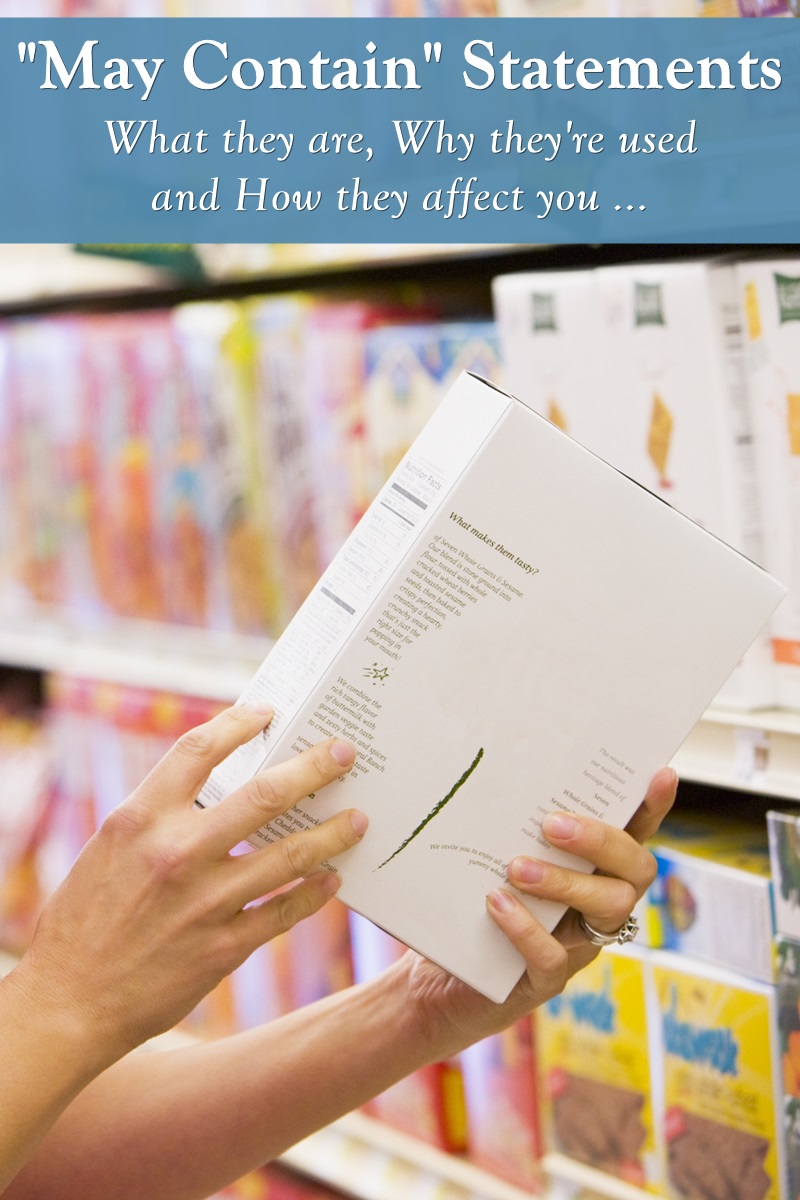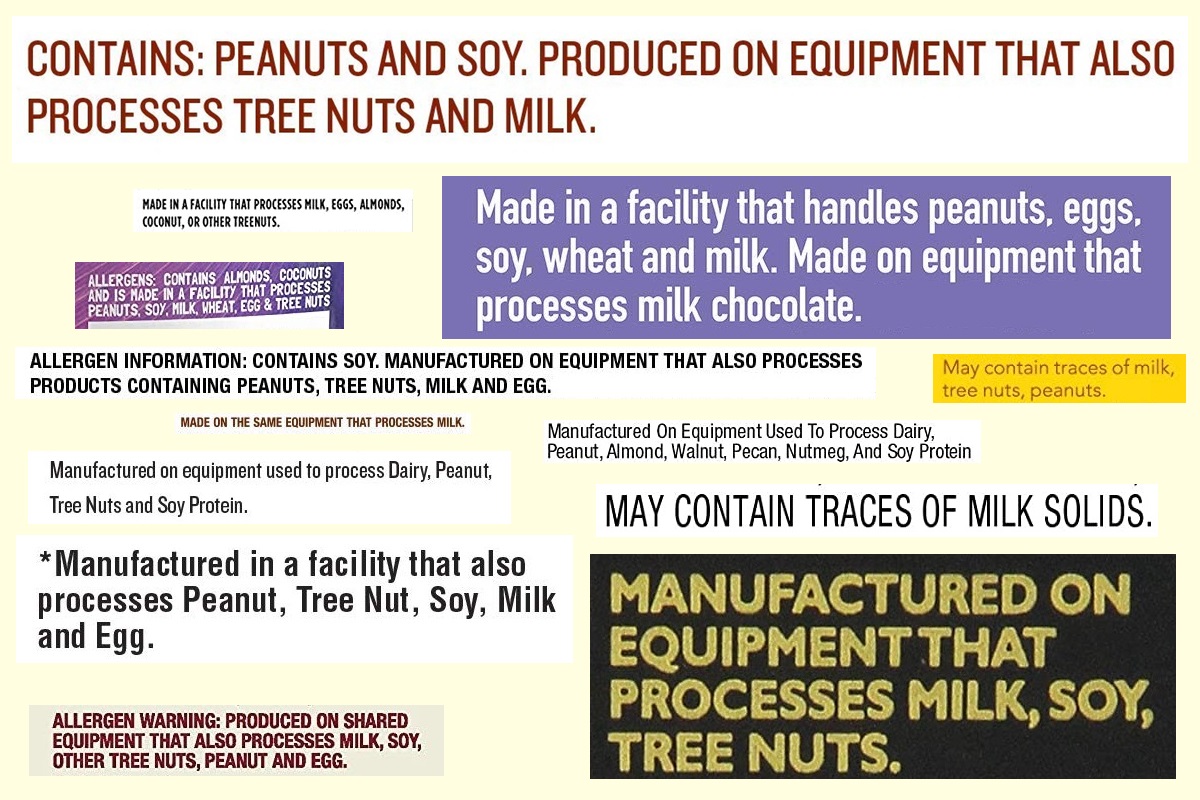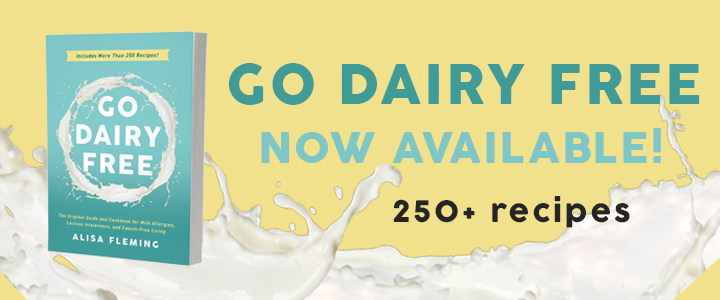It probably happens nearly every time you go to the grocery store. You pick up a product that looks dairy free or even states “vegan” on the label, and turn it over to see a statement like “may contain milk.” It’s confusing for most consumers, but I’ve got the facts to clarify what this means and to help you decide if it matters for you.

What are “May Contain” Statements on Food Labels?
“May contain” statements are a manufacturer’s warning that the product might have been somewhere in the vicinity of another product that contains the allergen noted at some time during the production process.
They are not stating that there is any of the allergen in the product. But it’s usually a caution that there is some degree of risk for some level of potential cross-contamination (usually trace) with the noted allergen.
Here are a few examples of what “may contain” statements might look like.
- May contain …
- Made on shared equipment with …
- Produced in the same facility as …
- May contain traces of …
- Manufactured in the same facility as products containing …
And the list goes on, since there is no guidance on how to write these precautionary statements, or definitions for what they mean.

Are “May Contain” Statements Required?
The emergence of “may contain” statements followed closely after the enactment of the Food Allergen Labeling and Consumer Protection Act (FALCPA), but they are not directly related to it.
The FALCPA requires disclosure of any allergens in the ingredients of food products. By law, most food producers must specify if a product “contains” one of the top allergens. But they do not have to state if a product might inadvertently come into contact with a top allergen during productions processes. “May contain” statements are completely voluntary, and aren’t even a recommendation of the FDA.
Why Doesn’t the FDA Regulate “May Contain” Statements?
We don’t anticipate the FDA will ever have guidelines for using these types of statements because they are very vague. Ingredient statements and “contains” labels can affirmatively tell a consumer what is in the product. But “may contain” statements only reiterate uncertainty. It’s difficult to create a black and white rule when you’re dealing with many shades of grey.
It’s possible that the FDA will offer more guidance on allergen labeling in the future. But they must first establish allergen thresholds that are considered safe for all or almost all allergic individuals.
Within minutes of eating an allergenic food, some people will go into anaphylactic shock. But there isn’t a fixed quantity of an allergen that will cause a reaction. Each person has their own allergy threshold, and that threshold can even change. This makes establishing a fair and safe testing level difficult. There have been discussions on food allergy thresholds, but this topic has yet to progress past the proposal stage.
Why Can’t Companies just Prevent Allergen Cross-Contamination?
Food production is much more complex than the average consumer can fathom. It includes supply chains where ingredients may come from various farm fields and pass through multiple plants, manufacturing lines on which varying batches of food may be mixed, and even separate packaging facilities handling a broad range of raw or finished goods. There are often countless opportunities for a product to be cross-contaminated with small amounts of ingredients from another food product.
To help mitigate this issue, food manufacturers are required to follow Good Manufacturing Practices (GMP). In 2016, GMP was updated to include food allergen safety procedures. Companies must now have procedures in place to help avoid cross-contamination with potential allergens. This usually includes thoroughly washing lines, and can also include steps like rotating food production on an “allergen schedule” and batch testing.
But the chain of food production from farm to grocery store still doesn’t happen in a vacuum.
I had the opportunity several years ago to sit in on a small group talk led by a few heads of leading food allergy-friendly brands. Their companies revolve around making products that are safe for their customers. And yet, they made it very clear that 100% allergen-free, without a trace, is impossible to guarantee. There are simply too many cogs in the production wheel.
However, they can follow strict cleaning protocols and test each batch to ensure they fall under a “safe” allergen threshold. This is usually below 20 ppm (parts per million), 10 ppm, or even 5 ppm.
Why don’t they don’t test down to 0 ppm? Because it isn’t possible. Food allergen tests can test down below certain levels, but they cannot test down to zero. It would also be challenging, if not impossible, for a company to consistently achieve 0 ppm of an allergen.

Should I Worry About “May Contain” Allergy Statements?
The decision on what information you use, and what information you avoid is always up to you. But as I discussed above, ALL products are at some degree of risk for some level of potential cross-contamination with allergens. It doesn’t matter if the product has a precautionary statement or not.
People who aren’t concerned about trace or small amounts of a top allergen getting into their food usually don’t worry about “may contain” notes. They simply look at the ingredients and any “contains” notes.
People who are concerned about trace or small amounts of a top allergen must contact the manufacturer to discuss their processes whether or not there’s a “may contain” statement. Again, these statements are not required. So a product without any allergen precautions might still be at high risk for potential cross-contamination with top allergens.
Some people with severe allergies or high sensitivities use the warnings to initially weed out products when they are concerned about potential cross-contamination. But this can cause them to miss out on potentially “safe” foods. Yes, some companies who print these statements actually practice rigorous GMP.
Does the Wording of a “May Contain” Statement Indicate the Level of Risk?
This is a big misconception among consumers, and rightfully so. A label that says “made on the same equipment as xyz allergen” or “may contain traces of xyz allergen” sounds a lot higher on the risk scale than one that says “made in the same facility as xyz allergen.” But the wording does not correlate to the level of cross-contamination risk.
As mentioned, these statements are completely unregulated, and have no formal definitions. Companies can choose to add these labels or not, and they can choose to word them however they want.
For example, a company might state “produced in a facility that handles milk” on the label. That doesn’t sound risky, right? But that statement doesn’t mean the milk-containing products aren’t made by the same workers, on a line right next to the product your considering, or even on the same equipment. That statement doesn’t tell you if any type of product segregation or strict allergen protocols were followed for that product. It essentially tells you just one tiny bit over nothing.
Meanwhile, there might be a company that labels their product with a “made on the same equipment as xyz allergen” that properly rotates production runs and follows stricter allergen protocols.
Why are “May Contain” Statements Used?
Some companies are valiantly taking it into their own hands to warn consumers of potential cross-contamination risk. But in most cases, companies just don’t want the liability of someone with a severe food allergy consuming their product without being aware of the risks. These statements are an extra line of defense against potential recalls or lawsuits, which could occur if someone had an allergic reaction to their product.
Why are Some Products with “May Contain Milk” Statements Listed on Go Dairy Free?
Please repeat after me:
ALL products are at some degree of risk for some level of potential cross-contamination with allergens.
We cannot decide what level of risk is safe for you. Only you can make that decision. And if we only shared products that were tested 100% free of all traces of dairy all the time, then we wouldn’t share any products – period.
As mentioned above, “may contain” statements are completely voluntary, and can appear on “safe” or “unsafe” products. They don’t tell you what the company’s cleaning and testing protocols are, and a lack of one doesn’t mean a product is allergy-friendly. You have to talk to the company to find out.
If we used unregulated “may contain” statements as a guide for what we shared, then we would be making safety decisions for you. We can’t and won’t do that.
To further explain, let’s imagine a scenario where we only shared products without any type of a ‘may contain’ label for milk. Would you then assume that we only shared dairy “safe” products? Would others? As I’ve outlined, those statements are unregulated, and a lack of one doesn’t mean the product is made in a free-from facility. And it doesn’t mean every ingredient sourced for that product was produced and transported in free-from isolation. But we would be implying that those products met some standard for allergen safety simply because they didn’t have a voluntary statement. That is unsafe.
We can only use information that is regulated. At present, that includes the ingredients statement and the disclosure of top allergen ingredients for foods regulated by the FDA. Other food and alcohol regulators have recommendations, but do not have official allergen regulations.
We’re Here for All Dairy-Free People
Go Dairy Free caters to the entire range of dairy-free consumers – from health-oriented foodies to milk allergy families, and everything in between. Some of you just want dairy ingredient-free options, and some of you need products safe for severe food allergies. There is no way that we can or will speculate which foods are suitable or safe for you. But we hope that by sharing a range of dairy-free product options, you will find some that fit your needs.
If you are dealing with a severe food allergy, you must ALWAYS contact the manufacturer to discuss their processes before considering consumption. They are the only ones who can confirm their current cleaning and testing processes. Food labels and resources like Go Dairy Free are merely guides to help offer options, but cannot replace your own due diligence or decisions.


6 Comments
Hi. I am getting very suspicious of these ‘may contain’ clauses. My problem is casein and I seem to get a reaction all too often when eating them. But it would be very reassuring if there were some limit to what the makers are permitted to allow through on that basis. Below “20 ppm (parts per million), 10 ppm, or even 5 ppm” sounds very low, and I am hopefully not reactive at such levels. But there is of course no way to know. Any info gratefully received.
You can contact the companies directly to find out if they have allergen protocols. If so, they should be able to give more information on the protocols, including if they test below a certain amount.
a better word could be “exposed to…” like it has not been added on purpose but just closed to
Thank you for the information.
Where should the advisory statement be placed on the packaging if the product doesn’t contain any allergens?
Should it be placed right after the ‘Other ingredients’ (ingredients statement)?
Thank you for your time!
There are no regulations regarding may contain statements, so there is no place where it should be placed. But typically, companies put these vague statements after / below the ingredients if there is no contains statement.
After experiencing two separate allergic reactions recently, I re-read the list of ingredients for Country Crock plant butter sticks with almond oil and found that I had overlooked an ingredient: pea protein. I am allergic to peas!
A dipenhydramine and a breathing treatment got me through! For some people, an allergic reaction can be life threatening.
I am thankful for the ingredient list requirement. We just have to be very careful to READ IT THOROUGHLY!
BTW … Some of the Country Crock products contain Fava Bean (they call it faba), a close relative of the pea.
I will stick with Earth Balance! (FYI-Contains soy).